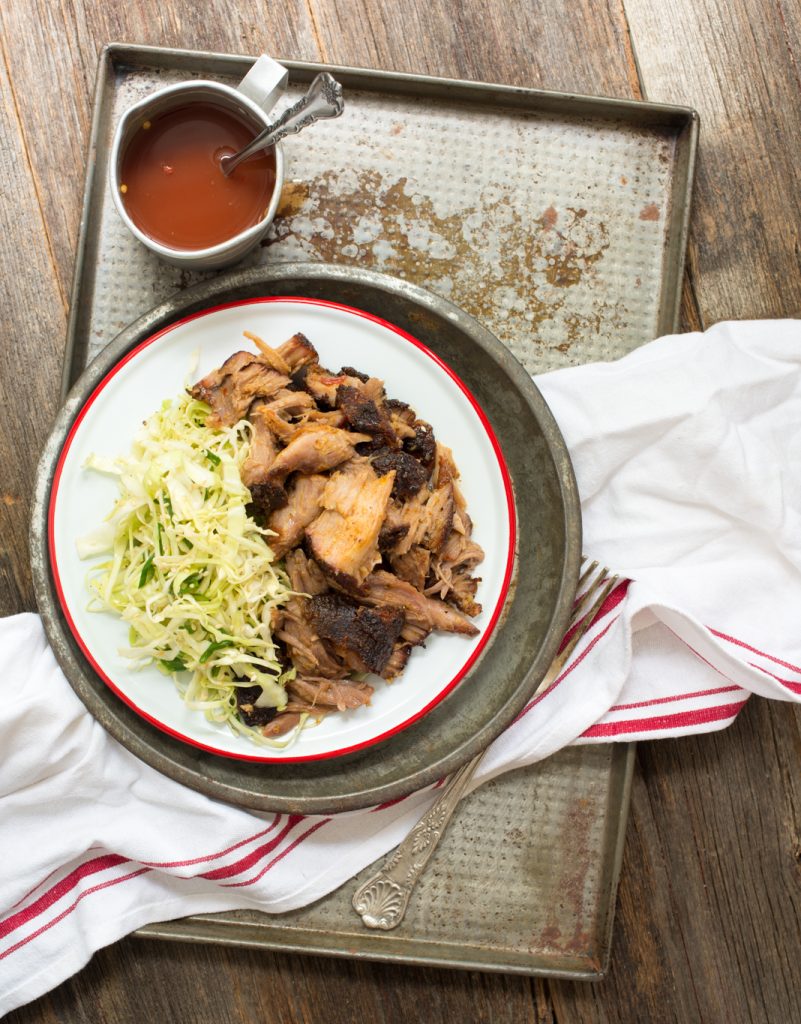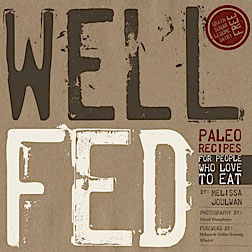In each issue of Paleo Magazine, I team up with Steph Gaudreau to share the history of a traditional recipe and adapt it to fit into a...
Read MoreBBQ Pork & Coleslaw
In each issue of Paleo Magazine, I team up with Steph Gaudreau to share the history of a traditional recipe and adapt it to fit into a healthier paleo lifestyle. (I write the words; she makes the gorgeous photos.) In a previous column, we peeked through the smoke to get to the heart of regional barbecue.
Smoke & Bones
You would think something as primal as meat cooked over a low flame would be simple: rub the meat with spices, smoke it until it’s tender, douse it with sauce, and grab a pile of napkins before you dig in.
But as I learned when I was transplanted in Texas, nothing about barbecue is simple to the connoisseurs who smoke it. Even something as seemingly innocuous as barbecue sauce is the source of delicious contention.
Regional barbecue tends to be defined by the spice rub or marinade that coats the meat before it’s cooked, and the type of sauce—or lack thereof—when it comes off the fire. There’s also a fair amount of chest beating about which cuts and types of meat truly define barbecue. Some swear by pork shoulder and ribs, while others contend it’s all about beef brisket.
The southern barbecue of Tennessee and the Carolinas tends to glorify the pig on the plate. Hogs were introduced to America by the Spaniards, and they soon turned feral. (The hogs, not the Spaniards.) This luck of empire building established pork as the go-to meat for barbecue in places like Lexington, Charleston, and Memphis. The sauce is where these traditions diverge. Your combo plate in Memphis will be drizzled with a thin, tangy tomato sauce, but in South Carolina, it’s a mustard-based sauce with brown sugar and vinegar. Head to its northern neighbor, and you’ll find the meat is basted with a thin, ketchup-based glaze.
The western border of barbecue country is loosely formed by the line from Texas to Missouri, and along that frontier, the meat of choice is usually beef, with a special fondness for fatty brisket (known as “moist” to aficionados). The meat is usually rubbed with spices and cooked ultra-slowly over hardwood, then served with a rich, sticky, tomato-based sauce on the side. (Always on the side! Never on the meat!)
My barbecue and slaw recipes are a mash-up of flavors from some of my favorite Texas and Southern barbecue experiences. (True barbecue is never just a meal; it’s an experience.) The spice rub is Memphis-influenced, but the sauce is North Carolina style, and the Hawaiian coleslaw is tribute to the light, crisp slaw served at The Salt Lick BBQ in central Texas. I’ve assumed two things about you and planned the recipes accordingly: (1) You don’t have a barbecue pit in your backyard, and (2) You don’t have12 to 18 hours available to tend a wood fire. This pork butt gets a quick, effective smoking on a gas grill, then finishes in the oven, so it requires very little attention from you. I recommend you serve the pork Texas-style with sliced raw, white onion and dill pickles. The wood chips needed to smoke the meat can usually be found near the charcoal at your local grocery store.
 Easy Smoked BBQ Pork
Easy Smoked BBQ Pork
Serves a lot! | Prep 20 minutes | Grill 2 hours | Oven 3 hours
Ingredients
Pork:
4-5 pounds boneless pastured pork shoulder or pork butt (You want a big ol’ fatty hunk of pork.)
3 tablespoons coconut sugar (omit for Whole30)
2 tablespoons ground paprika
2 tablespoons ground black pepper
2 tablespoons ground cumin
1 tablespoon salt
4 cups wood chips
BBQ Sauce:
1 cup water
1 cup cider vinegar
1/2 cup Kickass Ketchup
1 tablespoon maple syrup or honey (omit for Whole30)
3/4 teaspoon salt
1/2 teaspoon ground black pepper
1/2 teaspoon crushed red pepper flakes
Garnish:
white onion, sliced 1/4-inch thick
dill pickle chips
Directions:
Season the butt. Mix all the spices together and massage the blend all over the pork; be sure to get it into all the nooks and crannies. Set it aside while you prep the grill.
Smoke it, baby. Place the wood chips in a bowl and cover them with water. Soak them for 15 minutes, then drain off the water. Place the damp wood chips on a large piece of aluminum foil. Fold the foil to make a packet, then poke a few holes in the packet so smoke can escape. Place the packet on the primary burner of your gas grill, turn all the burners to high, and preheat with the lid down. After about 15 minutes, the wood chips will start to smoke.
Place the butt. When the grill is hot and the chips are smokin’, turn the primary burner to medium and turn off the other burners. Place the pork on the cool part of the grill, close the lid, and let it smoke for about 2 hours. You want a dark, rosy crust.
The Big Finish. Preheat the oven to 325F. When the pork is done smoking, place it in a roasting pan, wrap it tightly with foil, and roast in the oven for 2 to 3 hours, until you can insert a fork and remove it with no resistance. Now you need to be patient just a little bit longer: Remove the pork from the oven and let the it rest, still wrapped in the foil, for 30 minutes.
Make the sauce. Place all the ingredients in a pint-size Mason jar and shake it like you mean it.
To serve, break the pork into hunks, mixing it with a little of the sauce to coat the crispy bits and tender interior. Serve remaining sauce on the side, along with pickles and onions.
Hawaiian-Style Cole Slaw
Serves 4-6 | Prep 15 minutes
Ingredients:
1/2 head green cabbage
2 tablespoons sesame seeds
4 scallions, green only, thinly sliced
1/4 cup rice vinegar
1/4 cup distilled white vinegar
1 tablespoon coconut sugar (omit for Whole30)
1/2 tablespoon salt
1/2 teaspoon ground black pepper
pinch celery seed
1 tablespoon toasted sesame oil
2 tablespoons light-tasting olive oil
Directions:
Shred the cabbage. Use the slicing blade of a food processor to shred the cabbage; set aside.
Toast the sesame seeds. Heat a nonstick skillet over medium-high heat and stir-fry the sesame seeds until golden, about 3 minutes. Transfer them to a plate to cool.
Make the dressing. In a large mixing bowl, whisk together the rice vinegar, white vinegar, sugar, salt, pepper, and celery seed. Continue whisking as you add the sesame oil and the olive oil. Add the cabbage and scallions to the bowl. Toss well to coat, add the sesame seeds, and toss again.
For more delicious recipes like this one, subscribe to Paleo Magazine.
Still hungry? Try these
In each issue of Paleo Magazine, I share the history of a traditional recipe and adapt it to fit into a healthier paleo lifestyle. For...
Read More




Hi, Mel!
I seem to have lost you when you moved to Prague – nothing comes to my email from you. Please put me in your “Q” so I get your posts. Hope all is well with you guys
I continue to use all three of your cookbooks every week – they’re my “go to” of all my paleo cookbooks.
Linda Campbell
OK! I added the email address you used to comment here to my mailing list. You should get my newsletters on Thursdays (unless I’m lazy 😉
This. rocks. I am often speechless at your mastery of spices, and while I consider myself a pretty good cook, your recipes always add that extra taste “edge”. I had never seriously considered attempting to smoke with the gas grill—lo and behold it works! The whole fam loved this, and my son especially loves the “glorious fat”. haha. This is now on rotation along with a number of your other recipes. 😉
Glorious fat, indeed! Glad it was a hit! Thanks for letting me know you liked it!